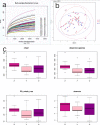Enriched and Decreased Intestinal Microbes in Active VKH Patients
- PMID: 35142786
- PMCID: PMC8842635
- DOI: 10.1167/iovs.63.2.21
Enriched and Decreased Intestinal Microbes in Active VKH Patients
Abstract
Purpose: To determine the possible microbiome related to Vogt-Koyanagi-Harada (VKH) disease in comparison to patients with noninfectious anterior scleritis and healthy people.
Methods: Fecal samples were extracted from 42 individuals, including 11 patients with active VKH, 11 healthy people, and 20 patients with noninfectious anterior scleritis. We amplified the V3 to V4 16S ribosomal DNA (rDNA) region to obtain the target sequence. Then, the target sequence was amplified by polymerase chain reaction. The obtained target sequences were sequenced by high-throughput 16S rDNA analysis.
Results: At the genus level, there were three enriched (Stomatobaculum, Pseudomonas, Lachnoanaerobaculum) and two depleted (Gordonibacter, Slackia) microbes that were detected only in patients with VKH. There were 10 enriched and 12 depleted microbes that were observed in both patients with VKH disease and noninfectious anterior scleritis (P < 0.05). The interactions of these microbes were graphed. Tyzzerella and Eggerthella were the nodes of interaction between these microorganisms, which were regulated by both positive and negative aspects, but the expression level in patients with active VKH was upregulated.
Conclusions: Special or nonspecial enrichment and decreased intestinal microbes were observed in patients with active VKH. The action mechanism of these microbes needs further study.
Conflict of interest statement
Disclosure:
Figures




Similar articles
-
Alterations of the Enteric Virome in Vogt-Koyanagi-Harada Disease.Invest Ophthalmol Vis Sci. 2025 Jun 2;66(6):15. doi: 10.1167/iovs.66.6.15. Invest Ophthalmol Vis Sci. 2025. PMID: 40465264 Free PMC article.
-
Altered gut microbiome composition in patients with Vogt-Koyanagi-Harada disease.Gut Microbes. 2020 May 3;11(3):539-555. doi: 10.1080/19490976.2019.1700754. Epub 2020 Jan 13. Gut Microbes. 2020. PMID: 31928124 Free PMC article.
-
Comparison of intestinal microbes and metabolites in active VKH versus acute anterior uveitis associated with ankylosing spondylitis.Br J Ophthalmol. 2025 Feb 24;109(3):353-361. doi: 10.1136/bjo-2023-324125. Br J Ophthalmol. 2025. PMID: 37821210
-
The emerging role of epigenetics and gut microbiota in Vogt-Koyanagi-Harada syndrome.Gene. 2022 Apr 15;818:146222. doi: 10.1016/j.gene.2022.146222. Epub 2022 Jan 29. Gene. 2022. PMID: 35092860 Review.
-
Vogt-Koyanagi-Harada syndrome in patients of Vietnamese ancestry.Aust N Z J Ophthalmol. 1996 May;24(2):147-9. doi: 10.1111/j.1442-9071.1996.tb01570.x. Aust N Z J Ophthalmol. 1996. PMID: 9199747 Review.
Cited by
-
Comparison of Intestinal Microbes in Noninfectious Anterior Scleritis Patients With and Without Rheumatoid Arthritis.Front Microbiol. 2022 Jun 9;13:925929. doi: 10.3389/fmicb.2022.925929. eCollection 2022. Front Microbiol. 2022. PMID: 35756002 Free PMC article.
-
Gut microbiome dysregulation in noninfectious uveitis.Front Immunol. 2025 Jul 29;16:1614304. doi: 10.3389/fimmu.2025.1614304. eCollection 2025. Front Immunol. 2025. PMID: 40799652 Free PMC article. Review.
-
From Dysbiosis to Disease: The Microbiome's Influence on Uveitis Pathogenesis.Microorganisms. 2025 Jan 25;13(2):271. doi: 10.3390/microorganisms13020271. Microorganisms. 2025. PMID: 40005638 Free PMC article. Review.
-
Microbiome-based therapeutics for ocular diseases.Clin Exp Optom. 2025 Mar;108(2):115-122. doi: 10.1080/08164622.2024.2422479. Epub 2024 Dec 1. Clin Exp Optom. 2025. PMID: 39617011 Review.
-
Alterations of the Enteric Virome in Vogt-Koyanagi-Harada Disease.Invest Ophthalmol Vis Sci. 2025 Jun 2;66(6):15. doi: 10.1167/iovs.66.6.15. Invest Ophthalmol Vis Sci. 2025. PMID: 40465264 Free PMC article.
References
-
- Yang P, Liu S, Zhong Z, et al. .. Comparison of clinical features and visual outcome between sympathetic ophthalmia and Vogt-Koyanagi-Harada disease in Chinese patients. Ophthalmology. 2019; 126: 1297–1305. - PubMed
-
- Egbeto IA, Garelli CJ, Piedra-Mora C, et al. .. Case series: gene expression analysis in canine Vogt-Koyanagi-Harada/uveodermatologic syndrome and vitiligo reveals conserved immunopathogenesis pathways between dog and human autoimmune pigmentary disorders. Front Immunol. 2020; 11: 590558. - PMC - PubMed
-
- Read RW, Holland GN, Rao NA, et al. .. Revised diagnostic criteria for Vogt-Koyanagi-Harada disease: report of an international committee on nomenclature. Am J Ophthalmol. 2001; 131: 647–652. - PubMed
Publication types
MeSH terms
Substances
LinkOut - more resources
Full Text Sources

